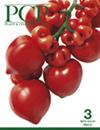Chloride: from Nutrient to Toxicant.
Abstract
In salinized soils in which chloride (Cl-) is the dominant salt anion, growth of plants that tolerate only low concentrations of salt (glycophytes) is disturbed by Cl- toxicity. Chlorotic discolorations precede necrotic lesions, causing yield reductions. Little is known about the effects of Cl- toxicity on these dysfunctions. A lack of understanding exists regarding (i) the molecular and physiological mechanisms that lead to Cl--induced damage and (ii) the adaptive aspects of induced tolerance to Cl- salinity. Here, mechanistic explanations for the Cl--induced stress responses are proposed and novel ideas and strategies by which glycophytic plants avoid the excessive accumulation of Cl- are reviewed. New experiments are suggested to test the proposed hypotheses. Cl- salinity constrains global food security and thus we urgently need more research into the causes and consequences of Cl- salinity.





